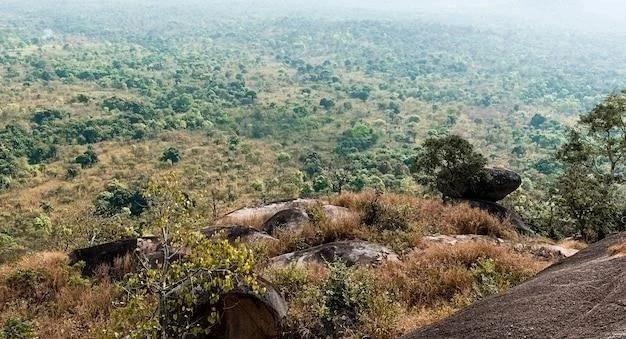Nestled within the bustling metropolis of Mumbai, India, lies a verdant sanctuary teeming with life: the Sanjay Gandhi National Park (SGNP). A testament to the harmonious coexistence of nature and urban sprawl, SGNP offers a unique escape for both wildlife and city dwellers seeking respite.
A Historical Haven
Established in 1969, SGNP, originally known as Borivali National Park, sprawls over 104 square kilometers. This protected area boasts a rich history, evidenced by the presence of the ancient Kanheri Caves. These 2,400-year-old rock-cut caves, carved into the basalt cliffs, served as a significant Buddhist learning center for centuries.
Biodiversity at its Finest
Despite its urban setting, SGNP harbors a surprising diversity of flora and fauna. The park provides refuge to:
- Mammals: Over 35 mammal species, including leopards, spotted deer, bonnet macaques, and Indian flying foxes, thrive within the parks boundaries. The presence of these large predators, particularly leopards, highlights the parks success in conservation.
- Avifauna: Birdwatchers flock to SGNP to spot over 274 avian species. From vibrant kingfishers and sunbirds to majestic raptors like the white-bellied sea eagle, the park offers a visual feast for bird enthusiasts.
- Reptiles and Amphibians: The parks diverse habitats support a variety of reptiles, including pythons, cobras, and monitor lizards, as well as several amphibian species.
- Flora: Lush forests, dominated by teak, bamboo, and acacia, define the parks landscape. The undergrowth teems with a variety of shrubs, herbs, and wildflowers, creating a vibrant tapestry of colors.

A Refuge for City Dwellers
Beyond its ecological significance, SGNP serves as the lungs of Mumbai, providing much-needed green space for the citys inhabitants. The park offers a range of recreational activities, including:
- Nature Trails: Explore the parks diverse habitats on foot, immersing yourself in the sights and sounds of nature.
- Boating: Enjoy a leisurely boat ride on the parks lake, offering a different perspective of the surrounding wilderness.
- Lion & Tiger Safari: Embark on a thrilling safari to catch a glimpse of the parks resident big cats in a controlled environment.
- Kanheri Caves Exploration: Journey back in time as you explore the ancient Buddhist caves, marveling at their intricate carvings and historical significance.

Conservation Challenges and Successes
As an urban park, SGNP faces unique challenges, including habitat fragmentation, human-wildlife conflict, and encroachment. However, through dedicated conservation efforts and community engagement programs, the park authorities strive to mitigate these threats and ensure the long-term survival of its biodiversity.

Planning Your Visit
SGNP is easily accessible from various parts of Mumbai. The park is open to visitors throughout the year, though the best time to visit is during the cooler months, from October to May.
Essential Information:
- Entry Fee: Nominal fees are charged for park entry and various activities.
- Timings: The park is open from sunrise to sunset.
- Getting There: The park is well-connected by road and public transportation. The nearest railway station is Borivali.
A Sanctuary for All
Sanjay Gandhi National Park stands as a shining example of urban conservation, offering a unique opportunity to connect with nature amidst the urban jungle. Whether you seek adventure, tranquility, or a glimpse into Indias rich natural heritage, SGNP promises an unforgettable experience.
Navigating the Challenges of Urban Conservation
The proximity of Sanjay Gandhi National Park to a major metropolitan area presents unique challenges. Encroachment pressures, human-wildlife conflict, and the impact of pollution necessitate proactive conservation strategies. SGNP authorities, in collaboration with conservation organizations and local communities, are actively engaged in addressing these concerns.
Mitigating Human-Wildlife Conflict
The presence of leopards within SGNP, while a testament to the parks ecological integrity, requires careful management to minimize human-wildlife conflict. Public awareness campaigns, focused on leopard behavior and safety measures, play a crucial role. Additionally, efforts to secure garbage dumps and discourage the feeding of wildlife are essential in reducing potential conflict.
Habitat Connectivity and Corridor Management
Maintaining habitat connectivity is crucial for long-term species viability, particularly for wide-ranging carnivores like leopards. SGNP authorities are actively working to identify and manage critical wildlife corridors that connect the park to other forested areas. These corridors facilitate gene flow and reduce the risk of isolation for wildlife populations.
A Model for Urban Biodiversity Conservation
Sanjay Gandhi National Park stands as a beacon of hope for urban conservation, demonstrating that nature can thrive even in the most densely populated areas. Its success hinges on a multi-pronged approach that integrates scientific research, community engagement, and effective park management. As cities worldwide grapple with the challenges of urbanization, SGNP serves as a valuable model for integrating biodiversity conservation into urban planning and development.
A Legacy for Future Generations
The legacy of Sanjay Gandhi National Park extends far beyond its boundaries. It serves as a constant reminder of the interconnectedness of humans and nature, inspiring future generations to become stewards of the environment. By safeguarding this urban oasis, we ensure that the ecological and cultural treasures of SGNP will continue to enrich the lives of countless individuals for years to come.

Promoting Sustainable Tourism and Recreation
Sanjay Gandhi National Park recognizes the importance of balancing conservation goals with sustainable tourism and recreation opportunities. The park authorities have implemented various measures to minimize the environmental impact of visitor activities while ensuring an enriching experience.
Regulated Access and Visitor Management
To minimize disturbance to wildlife and sensitive habitats, visitor access to certain areas within SGNP is regulated. Designated trails, guided tours, and designated picnic areas help channel visitor traffic and minimize off-trail excursions.
Environmental Education and Interpretation
SGNP plays a vital role in environmental education, fostering a sense of appreciation and stewardship for the natural world. The park offers a range of interpretive programs, nature trails with informative signage, and educational exhibits at its visitor centers. These initiatives aim to raise awareness about the importance of biodiversity conservation and encourage responsible behavior within the park.
Community Engagement and Collaboration
Recognizing the importance of community support in conservation efforts, SGNP actively engages with local communities residing in and around the park. Participatory conservation programs, involving local residents in wildlife monitoring, habitat restoration, and anti-poaching activities, foster a sense of ownership and responsibility for the parks well-being.
Looking Ahead: A Future of Resilience and Coexistence
As Sanjay Gandhi National Park continues to evolve in the face of urbanization and climate change, its role as a refuge for biodiversity and a sanctuary for city dwellers becomes ever more crucial. The ongoing commitment to adaptive management, scientific research, and community engagement will be paramount in ensuring the parks resilience and its ability to provide ecological and societal benefits for generations to come. SGNP stands as a testament to the power of human ingenuity and dedication in harmonizing urban development with the preservation of our natural heritage.










